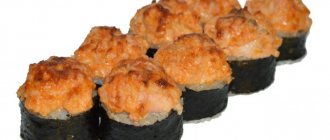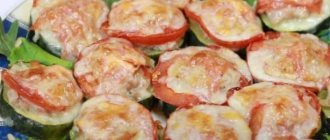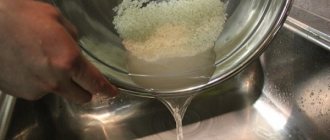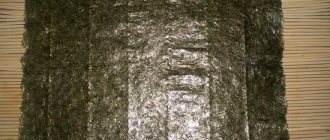What is the name of
Japanese omelet is a broad concept that includes several types of omelettes:
- Tamago-yaki or tamago
is the main and most popular type of omelette among the Japanese, which is a roll of several thin egg pancakes. And the name translates simply - “fried egg.” - Omuraisu
is a very filling omelette filled with rice. Its name translates as “rice in an omelet.” You can supplement the rice filling with any vegetables or mushrooms. - Oyakodon
is an omelette filled with rice and chicken. - Chavan mushi
is a liquid steam omelette that is prepared in special bowls. The name of the dish is translated from Japanese as “steamed bowl”.
What kind of frying pan do you need?
In Japan, omelette is prepared in large square frying pans with low sides, greasing the bottom with a piece of oiled cloth. In such a bowl it is easy to roll an omelette or wrap the filling.
If you don’t have such a vessel in your kitchen, then an ordinary pancake frying pan is quite suitable for preparing a Japanese omelette.
The main requirement is that nothing sticks to the pan. A pancake maker with a non-stick or marble coating is ideal.
You can also use a square or rectangular metal baking pan as a square pan. Place it on the stove and fry the omelet as if in a frying pan.
Cooking - step by step recipe
Before preparing the tomago omelette , take a frying pan with low sides, or preferably a pancake pan. It's good if it's a low rectangular frying pan. You also need a wooden spatula for turning omelette pancakes. All is ready? Then let's get started.
- Beat chicken eggs into a deep bowl, add sugar and salt. Beat the mixture thoroughly with a whisk.
- Add soy sauce, then rice vinegar. We work with the whisk again so that we get a mass of homogeneous consistency.
- Strain the mixture through a fine sieve. Enriching the mixture with oxygen will make the tomato omelet more fluffy.
- Heat the frying pan and grease it with vegetable oil. Now pour some of the omelette mixture onto the bottom and distribute evenly over the bottom. The principle is the same as for pancakes.
- As soon as the layer sets, roll it into a roll using a spatula. To do this, grab it by the edge, put it a little on the omelette pancake and start twisting it in the opposite direction. We leave the roll on the very edge (almost on the side).
- Grease the bottom with oil and pour in the second portion of the mixture. Quickly distribute the dough over the pan and immediately roll the wrapped roll onto the edge of the baking pancake.
- As soon as the second layer is baked, with a spatula we begin to wrap the layer into a roll along with the first pancake. We will get a roll in a roll. Place the workpiece on the side.
- Coat the bottom with oil and pour in the third portion of the mixture. Immediately place the finished tamago roll from the edge of the layer and bake the layer. As soon as it sets, we twist it according to the same principle.
How to cook Japanese omelette at home
Such an exotic breakfast as a Japanese omelette can be easily prepared at home. The dish uses simple ingredients that can be easily purchased in the store.
The required ingredients are eggs and soy sauce. If it is not possible to purchase any component, it can be replaced with any analogue. The authenticity of the dish will suffer a little from this, but the taste itself will not change significantly.
There are a lot of options for preparing Japanese omelette; below we will look at several step-by-step recipes.
For rolls
I use Tamago-yaki (egg omelet for sushi or rolls) not only for wrapping rolls and sushi, but also served as an independent dish.
An omelette looks like a roll of several egg pancakes. It must contain soy sauce and rice wine.
Compound:
- 3 eggs;
- 1 tbsp. Sahara;
- 1 tbsp. Mirina (rice wine);
- 1 tsp soy sauce;
- a little vegetable oil.
Preparation:
- Wash the eggs, break into a bowl and stir with a whisk until smooth. Add mirin, soy sauce and granulated sugar and mix again.
- Wipe a large hot frying pan with a piece of cloth soaked in vegetable oil. Pour in a little egg mixture and fry the pancake for a couple of minutes without turning.
- As soon as the pancake has set, roll it into a roll with a spatula (sticks) and move it to the near edge of the pan.
- Oil the bottom of the frying pan again, pour in a new portion of eggs and fry until done.
- Place the previously prepared roll on the edge of the second pancake and wrap it in the same way, moving it to the side.
- Using the same principle, fry a few more egg pancakes, wrapping them in one common roll.
- Place the finished tamagoyaki on a mat to form sushi, shape the roll into a square shape, cut into portions and serve with any sauce.
Calorie content: 158 kcal per 100 g.
Rice
Japanese rice omelette or omurice is a complete dish because... complemented with boiled rice, vegetables and mushrooms.
Compound:
- 1 tbsp. brown rice (boiled);
- 3 eggs;
- 0.5 tbsp. mushrooms (fresh or dried);
- 1 tomato;
- 1 onion;
- 2-3 tbsp. soy sauce;
- 0.5 chili pepper;
- 20 g vegetable oil;
- 2 cherry tomatoes;
- some herbs and spices.
Preparation:
- If dry mushrooms are used, they must first be soaked in hot water for a couple of hours. Peel the onion and cut into cubes. Grind soaked or fresh mushrooms in the same way.
- Place the vegetables and mushrooms in a frying pan with vegetable oil and simmer everything together over low heat for about 3-4 minutes.
- Wash the tomato, remove the skin, and puree it in a blender.
- Wash the chili, cut in half, remove the seeds, and chop finely.
- Add tomato puree, chili to the frying pan, season with salt and spices to taste. Mix everything, simmer for 3 minutes.
- Add boiled rice to the contents, season the filling with soy sauce and adjust the spices to taste.
- For an omelet, combine eggs, chopped herbs and soy sauce. Stir the whole mass thoroughly.
- Pour the egg mixture into a heated, oiled frying pan. Once the eggs are set around the edges, spread the filling in an even layer on one half of the omelet. Then carefully cover the filling with the other half of the pancake and press. Cover the dish with a lid and cook the omelette over low heat for 5-7 minutes until cooked.
- Remove the dish from the heat and leave covered for another 5 minutes.
- Place the Japanese-style omelette on a plate with fresh herbs and cherry halves, decorate with tomato sauce, and serve hot.
Calorie content: 123 kcal per 100 g.
In a bag
Japanese omelette in a bag stuffed with fried rice is somewhat reminiscent of the previous recipe, but differs in the composition of the filling and the way the dish is formed.
Compound:
- 1 onion;
- 0.3 kg chicken fillet;
- 6 tbsp. ketchup;
- 60 ml milk;
- 8 fresh eggs;
- 0.2 kg round rice;
- 3 tbsp. lean is small;
- a little table salt;
- 1 tsp butter.
Preparation:
- Wash the rice and boil it in salted water. Drain the water, but do not rinse the rice.
- Rinse, peel the onion, wash the fillet and cut both ingredients into cubes.
- Pour chopped onion into a frying pan with oil, after a couple of minutes add chicken, stir and fry for 5 minutes. At the end add a little salt to the filling.
- Add cooled rice with ketchup to the contents. Mix everything thoroughly and keep on the stove for another minute.
- Break the eggs into a bowl, mix with a whisk with milk (do not beat), adding a little salt to the egg mass.
- Grease the frying pan with butter, pour in a quarter of the omelette mixture, and fry a thin omelette until cooked. Do the same with the remaining three omelettes.
- Place the filling in the center of each pancake and roll it into a bag or boat. When serving, pour ketchup on thickly.
Calorie content: 190 kcal per 100 g.
With filling
Various ingredients and sauces are used for the filling. Just be sure to include rice and soy sauce.
Compound:
- 1 tbsp. boiled rice;
- 0.5 tbsp. vegetable mix (carrots, corn, zucchini, green peas);
- 1 chicken thigh;
- 2 tsp sunflower oil;
- 1 small onion;
- 1 tsp ketchup;
- 3 tbsp. grated cheese;
- 1 egg;
- 1 tsp soy sauce;
- 1 tbsp. milk;
- a little salt and pepper.
Preparation:
- Remove the skin from the onion and cut the head into small cubes. Place it in a frying pan and fry until soft.
- Wash the chicken thigh, remove the skin, cut out the bone. Cut the fillet into small cubes and add to the soft onion. Fry until the chicken changes color.
- Add the vegetable mix to the frying pan (you can use frozen vegetable mix), stir, season to taste with salt and black pepper.
- Add rice, soy sauce, ketchup and mix everything thoroughly.
- In a bowl, lightly beat the eggs with milk. Pour the mixture into a preheated, lightly oiled frying pan.
- As soon as half of the entire omelette mass has curled and the other remains liquid, place grated cheese on the liquid half of the omelette. Spread the toasted filling over the cheese.
- Using a spatula, carefully fold one edge of the pancake over the filling, then the other.
- Transfer the finished omelette to a plate, seam side down. Garnish with ketchup and serve warm.
Calorie content: 202 kcal per 100 g.
Oyakodon with rice and chicken
Chicken is often added to a Japanese omelette, and more than one dish in Japan is unthinkable without rice.
Photo: oyakodon - Japanese omelette with rice and chicken
Compound:
- 0.5 chicken fillet;
- 1 onion;
- 1.5 tbsp. rice (boiled);
- 3 fresh eggs;
- 1 tsp honey;
- 2 tbsp. soy sauce;
- 1 bunch of green onions.
Preparation:
- Peel the onion, cut in half and chop each half into thin half rings.
- Place the onions in a frying pan with nearly simmering soy sauce. Stir everything vigorously, after a minute add honey and stir. Simmer the onion until all the liquid has evaporated and it begins to brown (caramelize).
- Wash the chicken breast thoroughly, dry it, cut it into small cubes, and add it to the onion. Stir and keep on medium heat for about 7-8 minutes, stirring occasionally.
- Wash and finely chop the onion. Make scrambled eggs from eggs, adding greens. Pour the liquid mixture into the contents of the frying pan, cover with a lid for 4 minutes and cook over low heat. Then set aside.
- To serve, transfer the warm boiled rice to a deep plate, the diameter of which should match the circumference of the frying pan. Place a whole omelette pancake on top, turning the pan upside down.
Calorie content: 121 kcal per 100 g.
Steam
Chavan mushi is a special steamed omelette made from a mixture of eggs and broth. Many even consider it soup. This is almost the only Japanese dish that is eaten with a spoon.
Photo: chawan mushi or Japanese steam omelette
Compound:
- 0.2 kg chicken fillet;
- 1 bunch of parsley;
- 4 king prawns;
- 1 tbsp. sake;
- 2 eggs;
- 4 kamaboko plates (surimi sticks);
- 4 shiitake mushrooms (caps only);
- 400 ml dashi broth (fish broth infused with kombu seaweed);
- 50 ml soy sauce;
- 0.5 tsp salt.
Preparation:
- Wash and coarsely chop the chicken. Place the meat in a 2-liter saucepan, add water, and cook after boiling for about 20 minutes over medium heat.
- Remove the finished boiled chicken with a slotted spoon and marinate in a mixture of soy sauce and sake.
- Thoroughly wash the caps of the shiitake mushrooms, cut them into thin strips about 0.5 mm wide and 2 cm long.
- Pour fish broth (dashi or dashi) into another saucepan and season with 1 tsp. soy sauce, salt and boil over low heat. Then put the boiling broth aside and cool.
- Break the raw eggs into a bowl, mix with a whisk and pour into the cooled dashi. Strain the resulting mixture.
- Peel the shrimp, rinse, boil in a boiling liter of water for 10 minutes.
- Cut the kaboboko into thin slices.
- Place the marinated chicken along with the marinade, shrimp, shiitake, kamaboko in bowls for chawan mushi and pour egg broth over everything.
- Cover each bowl with cling film, using a toothpick to make several holes for steam to escape.
- Place the bowls in a wide saucepan, add warm water so that its level reaches half the height of the bowls, and cook after boiling for 20 minutes over medium heat.
- Remove the finished omelette from the film, sprinkle with fresh chopped parsley and serve immediately.
Calorie content: 115 kcal per 100 g.
Sweet
The sweet omelette is called tamagoyaki. You can eat it separately, or you can wrap it in sushi or rolls. For sweetness, sugar, powdered sugar or honey is added to the composition.
Compound:
- 4 fresh eggs;
- 1 tbsp. soy sauce;
- 1 tsp fresh honey;
- a little vegetable oil for frying.
Preparation:
- In a bowl, mix eggs with soy sauce and honey with a spoon until smooth.
- Pour a little vegetable oil into the frying pan or simply brush it with an oiled brush.
- Pour a ladle of the mixture and distribute it over the entire area of the pancake pan.
- Roll up the finished egg pancake and move it to the edge of the pan closest to you.
- Pour a new portion of omelette mixture onto the vacated space, pouring a little egg mixture onto the edge of the finished pancake to hold the pancakes together.
- Roll the finished pancake into a roll again.
- Repeat the procedure until the egg mass is finished.
- Transfer the finished omelette to a plate, cut into pieces, garnish with sweet sauce and sprinkle with sesame seeds.
Calorie content: 170 kcal per 100 g.
How to serve and what to serve with
The Japanese tomago omelette is eaten primarily for breakfast and served on an oval platter. Before serving, the roll is wrapped in a mat and given a rectangular shape.
Then put pressure on top until the dish cools completely, in order to flatten the roll a little before slicing:
- The uneven ends are cut off, and the rest is cut into even thick pieces.
- According to custom, soy sauce, fresh vegetables and herbs are always served with the omelet.
- The dish can be served warm or chilled.
There are many options for preparing Japanese omelet, so everyone can choose a recipe to their liking. And now every morning you can pamper your family with an unusual breakfast from the Land of the Rising Sun. Bon appetit everyone!
How to Serve Onsen Tamago
You can serve onsen tamago with soy sauce-based dashi, which is very often part of the Japanese breakfast. You can also place onsen tamago on top of steamed rice, sprinkle it with soy sauce, stir and start eating. You can also serve it with gyudon, curry rice, soba noodle soup and cold udon. Or you can just mix it with carbonara.
Now you can begin the cooking process itself. However, one very important point remains to be mentioned. Many people eat raw eggs, including the Japanese. But guidelines say eggs must be cooked to 74°C to be considered safe. However, I remind you that the ideal temperature for cooking onsen tamago is 65-68 °C, which is below the guideline. Therefore, there is a risk of salmonella disease.
Video: Japanese Street Food (Tokyo) - How they make Omelette in Japan #streetfood #fastfood
Dishes from the countries of the Rising Sun do not lose their popularity. Japanese omelette is an excellent option for breakfast - aromatic, filling and easy to prepare. The most interesting thing is that there are a lot of options for preparing an omelet, so every morning you can pamper your family with a new dish.
It is worth noting that the Japanese cook omelettes in a special square frying pan. But you can use a traditional pancake pan or non-stick frying pan.
Classic Omuraisu takes just 30 minutes to prepare.
Be careful - the dish is quite spicy, so it is not recommended for children.
List of ingredients for Omuraisu:
- a little bit of any oil for frying;
- 1 small hot pepper;
- 1 tbsp. l. soy sauce;
- 2-4 feathers of green onions;
- ⅕ teaspoon fine salt;
- 1 small onion;
- 2 stacks ready boiled rice;
- 6 eggs;
- 2 fresh shiitake mushrooms (oyster mushrooms, champignons).
Cooking step by step:
- Wash the hot pepper, remove the seeds and chop very finely.
- Wash the mushrooms, dry with a paper towel and cut into thin slices.
- Peel the onion, rinse with cool water and cut into small cubes.
- Heat the oil in a frying pan, add chopped peppers and onions, fry for 2-3 minutes.
- Add mushrooms to the vegetables, cook for another 4-5 minutes, stirring occasionally.
- Reduce heat, add rice and mix thoroughly. Make sure the filling is crumbly. After 5-7 minutes, turn off the heat and leave the filling covered.
- Wash the onion feathers. Cut into small rings.
- Beat the eggs, adding soy sauce. Add onion and mix thoroughly.
- Grease a baking sheet with oil, pour in the omelette mixture and place the dish in the oven. Bake at 200 degrees for 5-6 minutes. Then remove the pan and leave the omelette to cool slightly.
- Place the prepared rice filling evenly on one edge. Roll it into a roll and place it on a plate. Cut into small pieces. It is recommended to serve with light soy sauce.
Features of Japanese omelet
Japanese omelette is a traditional oriental dish. There is no particular difficulty in preparing it. The simplest products are used. Residents of Japan cook omelettes in a special rectangular frying pan. And they turn the egg pancakes over with traditional chopsticks. We can use an ordinary or pancake frying pan and a spatula. The Japanese serve pickled ginger or wasabi with their omelette. They can be replaced with ketchup with herbs or sour cream sauce with garlic. In general, there are a lot of options for preparing the dish. You can experiment with the ingredients yourself, choosing them to suit your taste.
In addition, there are many little cooking tricks. So, for example, rice should be steamed, then it will turn out crumbly, but if cooked in water, it will always stick together. If you use soy sauce, then no salt is needed, otherwise the dish may turn out to be too salty. Knowing these nuances will allow you to prepare a delicious omelet.
Japanese omelette with rice and vegetables
Japanese omelette with rice and vegetables is a delicious option for those who love a light and tasty breakfast.
To prepare a Japanese omelette you will need:
- 5 eggs;
- 10 grams of red onion;
- 5 grams of green onions;
- 30 grams each of green and red pepper.
- butter for frying.
- salt and black pepper to taste.
Cooking steps:
- Wash the vegetables, cut into small cubes and mix in one container.
- Beat eggs until smooth with ground pepper and salt.
- Heat butter in a frying pan. When it melts, pour the excess into a separate container. Make the fire slow.
- Pour a third of the omelet into the pan. Place a third of the vegetables on top. After 1-2 minutes, use a spatula to roll the omelette pancake with vegetables into a roll, but do not remove it from the pan, moving it to the edge of the vessel.
- Pour in a little more mixture and spread half of the remaining vegetables on top. After 1-2 minutes, wrap the rolled egg roll in a new omelette and also leave it on the edge of the pan.
- Pour in the rest of the egg mixture and add the last of the vegetables. As in the previous paragraphs, wrap the roll in a new omelette layer.
- Leave in the pan for 3-5 minutes, you can cover with a lid.
- Place the omelette on a bamboo mat and roll it so that the cooled roll takes on a slightly rectangular shape. Leave for 3-5 minutes to harden.
- Cut the omelette into equal pieces. Before serving, you can sprinkle with herbs.
Oyakodon omelette with rice and chicken as in the photo
Oyakodon is a variation of the Japanese dish donburi or doburimono. This is a large bowl of rice, into which various ingredients are added: meat, seafood, vegetables, tempura. The dish appeared around 1900 in Osaka. Initially, chicken pieces were thrown onto rice, filled with egg and sprinkled with herbs.
Translated from Japanese, oyakodon means “mother and child,” as the dish contains both chicken and egg. For us it's scrambled eggs with rice and chicken.
Stages and secrets of the recipe
There are quite a few recipes for oyakodon. They are all similar, but there are still some differences.
- Fillet or thighs. Instead of chicken thighs, put chopped pieces of chicken fillet. But this way the dish turns out a little dry. The thighs are juicier. If you use fillet, cut the pieces into pieces that are not too small.
- Without salt. The soy sauce makes the dish salty. Therefore, according to the recipe, salt is not added to the Japanese omelette.
- Steamed rice. To make the side dish crumbly, it is better to steam it. Rice cooked in a pan will come out sticky.
- Add dashi and mirin. In the land of the rising sun, instead of water with soy sauce, they use dashi broth (dashi), cooked with seaweed, fry, tuna or dried mushrooms. And also mirin - sweet rice wine. Thus, Japanese rice omelet has a large palette of aromas and tastes.
- With soy sprouts or green beans. In some recipes, soybean sprouts or some green beans (pre-boiled) are simmered along with the chicken. And then everything is covered with egg.
Recipe
You will need:
- chicken thighs - 4-5 pieces (without skin and bones);
- eggs - 2 pieces;
- onions - 2 medium;
- soy sauce - 70 ml;
- sugar - 30 g;
- chopped greens - 2 tablespoons;
- rice for serving.
Preparation
- Cut the onion into half rings and the chicken into thin pieces.
- Pour soy sauce and 3 tablespoons of water into a heated frying pan. Add sugar. Mix everything.
- After boiling, add chopped onion to the pan. Cook for 1-2 minutes.
- Add chicken thighs. Leave for 5 minutes, then stir.
- Beat the eggs with the addition of herbs. Gently spread over the meat.
- Cover until the egg mixture is ready.
- Pour a portion of rice into a deep plate, place oyakodon on top - the Japanese omelette with chicken and rice is ready.
When serving, you can decorate the dish with green onions, arugula, lettuce or other herbs. Pickled ginger is also a great garnish. The Japanese rice omelet recipe serves 2 servings.
Fragrant Japanese omelette with rice “Oyakodon”
A very tender and aromatic option for preparing the Oyakodon omelette - with rice.
You will need the following list of ingredients:
- 120 grams of boiled rice;
- 30 grams of tomato paste or ketchup;
- 2-4 large champignons;
- 2-3 sprigs of fresh cilantro;
- 3 eggs;
- 2 tablespoons of milk;
- salt and pepper to taste.
Preparation:
- Cut mushrooms and cilantro into small cubes.
- Beat eggs with milk until smooth.
- Fry the mushrooms for 5-7 minutes. Add boiled rice, tomato paste, pepper and salt. Mix well and fry for 10 minutes, stirring occasionally.
- Place the prepared filling in a plate and sprinkle with fresh herbs. Some of the greens can be left for decoration before serving.
- Pour the egg mixture into the pan. Wait until the future omelette hardens a little on the bottom side.
- Place the finished filling on half of the pancake and use a spatula to cover it with the other half.
Cut the roll into 2 parts and place on plates. Top with herbs and serve.
Oyakodon omelette with rice and chicken as in the photo
Oyakodon is a variation of the Japanese dish donburi or doburimono. This is a large bowl of rice, into which various ingredients are added: meat, seafood, vegetables, tempura. The dish appeared around 1900 in Osaka. Initially, chicken pieces were thrown onto rice, filled with egg and sprinkled with herbs.
Translated from Japanese, oyakodon means “mother and child,” as the dish contains both chicken and egg. For us it's scrambled eggs with rice and chicken.
Stages and secrets of the recipe
There are quite a few recipes for oyakodon. They are all similar, but there are still some differences.
- Fillet or thighs. Instead of chicken thighs, put chopped pieces of chicken fillet. But this way the dish turns out a little dry. The thighs are juicier. If you use fillet, cut the pieces into pieces that are not too small.
- Without salt. The soy sauce makes the dish salty. Therefore, according to the recipe, salt is not added to the Japanese omelette.
- Steamed rice. To make the side dish crumbly, it is better to steam it. Rice cooked in a pan will come out sticky.
- Add dashi and mirin. In the land of the rising sun, instead of water with soy sauce, they use dashi broth (dashi), cooked with seaweed, fry, tuna or dried mushrooms. And also mirin - sweet rice wine. Thus, Japanese rice omelet has a large palette of aromas and tastes.
- With soy sprouts or green beans. In some recipes, soybean sprouts or some green beans (pre-boiled) are simmered along with the chicken. And then everything is covered with egg.
Recipe
You will need:
- chicken thighs - 4-5 pieces (without skin and bones);
- eggs - 2 pieces;
- onions - 2 medium;
- soy sauce - 70 ml;
- sugar - 30 g;
- chopped greens - 2 tablespoons;
- rice for serving.
Preparation
- Cut the onion into half rings and the chicken into thin pieces.
- Pour soy sauce and 3 tablespoons of water into a heated frying pan. Add sugar. Mix everything.
- After boiling, add chopped onion to the pan. Cook for 1-2 minutes.
- Add chicken thighs. Leave for 5 minutes, then stir.
- Beat the eggs with the addition of herbs. Gently spread over the meat.
- Cover until the egg mixture is ready.
- Pour a portion of rice into a deep plate, place oyakodon on top - the Japanese omelette with chicken and rice is ready.
When serving, you can decorate the dish with green onions, arugula, lettuce or other herbs. Pickled ginger is also a great garnish. The Japanese rice omelet recipe serves 2 servings.
Recipe for Japanese rice omelette “Oyakodon” with rice and chicken
This dish can be not only a hearty breakfast, but also a quick dinner.
Ingredients for Japanese rice omelette recipe:
- 1 small onion;
- half a chicken fillet;
- ½ cup uncooked rice;
- 3 chicken eggs;
- 6 tablespoons of soy sauce;
- 2 tablespoons sugar;
- 20 grams of green onions.
Preparation:
- Peel the onion, cut the head into thin layers;
- Heat the sauce in a frying pan. When it starts to boil, add onion rings and sprinkle with sugar;
- Rinse the chicken, pat dry with a paper towel and cut into small cubes;
- Add chicken to sauce and onions, cook for 5-6 minutes;
- While the meat is stewing, prepare the egg mixture: beat the eggs until smooth. There is no need to add salt, as the sauce will provide the necessary saltiness;
- Boil the rice until it becomes crumbly;
- Pour the beaten eggs evenly over the meat. Cover the dish with a lid. Leave for 5-7 minutes.
- 4 eggs;
- 1 tbsp. l. soy sauce;
- 1 tbsp. l. sour cream or 2 l. milk.
The preparation is very simple: all the ingredients need to be thoroughly beaten and the pancakes fried in a heated, oiled frying pan.
Frying has its own nuances:
- Using a ladle, pour a small portion of the egg mixture into the pan;
- when the bottom side of the future pancake is fried, roll the omelette into a roll with a spatula or chopsticks and push it to one edge of the pan;
- pour in the next portion of the egg mixture so that it gets a little under the roll;
- after 2-3 minutes, when the new pancake is slightly fried, you can add any filling and roll, starting with the finished roll;
- Continue cooking in the same way until the egg mass and filling are finished.
If small sizes are preferred, you can get by with 2-3 pancakes per roll, and prepare a new one from the remaining mixture. It’s worth remembering that an omelette pancake wraps well when hot.
Many people imagine an omelet in the form of a fluffy egg mass, baked in the oven or fried in a frying pan. In fact, the height of the omelet depends on the size of the mold and the number of eggs. Most often, the omelet turns out low, in the form of a thick pancake. It is served on the table, folded in half or rolled up. This is exactly how the French, the inventors of this delicious dish, originally prepared omelettes. Moreover, they do not add milk or flour to the omelet.
The Japanese omelette is very similar to the French one. But, as in any national cuisine, in Japanese this dish was slightly adjusted taking into account the national culinary tradition and taste preferences of the people.
Login to the site
Hello, dear roll lovers! Today we invite you to make dishes that use the Japanese tamago omelette. This is a very common ingredient for rolls and therefore you need to try it all urgently. Forward!First, let's prepare the omelette itself: To prepare the Japanese tamago omelette we will need: 4 chicken eggs, 1 tbsp. l. sake or white wine, 1 tbsp. l. light soy sauce, 1 tbsp. Sahara.
1. Mix all ingredients until smooth. Strain through a fine sieve or cheesecloth to remove any protein lumps. 2. Pour a few spoons of omelette into a heated, oiled frying pan and bake a regular pancake. 3. Roll the pancake in three or four layers to make a roll 4-5 cm wide. 4. Push the resulting roll to the edge of the pan. 5. Pour a few spoons of omelette into the vacant space (it is important that the new pancake is in contact with the existing roll along its entire length), brown and wrap the existing pancake in a new layer. 6. Use the entire mass to obtain a thick roll. 7. Cool, cut into bars of the desired width. Video on how to make an omelet
To prepare Matero Roll we will need:
Shrimp Omelette Tobiko caviar Ground chili pepper Nori Rice 1. Prepare Japanese tamago omelette. Moreover, we need one pancake to wrap the roll in and another one for the filling. The omelette that we will use for the filling must be cut into strips 2. Roll uramaki from nori, rice, omelette strips, shrimp, tobiko caviar. For spiciness, add a little ground chili pepper. 3. Wrap the roll in an omelette pancake on top. 4. Cut the roll into 6 pieces and place on a plate. Link to Matero Roll recipe
To prepare Hokkaido Maki we will need:
Bell pepper Takuan Omelet Chili sauce Tobiko caviar Sesame Nori Rice 1. Prepare the Japanese tamago omelette and cut it into strips. 2. Cut the bell pepper and takuan into strips for the filling. 3. Roll uramaki from nori, rice, bell pepper, takuan, omelette and chili sauce. 4. Top with tobiko and sesame seeds. 5. Cut the roll into 6-8 pieces and eat. Link to Hokkaido Maki recipe
To prepare Ginawa Maki we will need:
Smoked eel Tobiko caviar Omelette Avocado Sesame Unagi sauce Nori Rice 1. Cut the avocado into thin slices for decoration. 2. Slice the smoked eel for the filling. 3. Prepare Japanese tamago omelette. 4. Roll uramaki from nori, rice, smoked eel, tobiko and omelette. 5. Decorate the roll with avocado slices and sprinkle with sesame seeds. 6. Cover the roll with cling film and press the makisu with a bamboo mat. 7. Cut directly into the film into 6-8 pieces and press again using makisu. Use only a sharp Japanese knife for cooking. 8. Eat the roll, pouring Unagi sauce on top. Link to Ginawa Maki recipe
To prepare Florida Roll we will need:
Sea bass Salmon Omelette Cucumber Avocado Nori Rice 1. Cut sea bass, salmon and cucumber for filling. 2. Slice the avocado for decoration. 3. Prepare Japanese tamago omelette. 4. Roll uramaki from nori, rice, cucumber, sea bass, salmon, omelette and cucumber. 5. Decorate the roll with avocado slices on top. 6. Cover the roll with cling film and press the makisu with a mat. 7. Cut into 6 pieces directly in the film and press again using makisu. 8. Remove the film. 9. Eat a roll. Link to Florida Roll recipe
Don't forget to add some Wasabi paste and pickled ginger when serving.
Use only a sharp Japanese knife for cooking. When preparing, do not forget that if you do not have an ingredient, you can do without it or replace it with something else. Try experimenting!
Our VKontakte group
Now you can purchase all the necessary products for making rolls from us.
Delivery is carried out throughout Russia (except for frozen products) and in Moscow (for the entire range).
You can always watch our new videos on the YouTube channel. Bon appetit! Myrolls.ru
Subtleties of cooking
- The main ingredient in many Japanese dishes is soy sauce. It is also added to omelettes. Therefore, the dish acquires a piquant taste and an unusual rich color.
- Sliced Japanese omelette is a bit like the rolls for which Japanese national cuisine is famous. It is fried in the form of thin pancakes, which are rolled up directly in the frying pan.
- To prepare it, use special square-shaped dishes so that the rolls are neat. But many housewives have no idea about such kitchen utensils. Therefore, Japanese omelette can be cooked in a regular frying pan. It should have low sides and a non-stick coating. A pancake pan works well for this purpose.
- In addition to soy sauce, the Japanese add rice vinegar to the omelette mixture. But in other regions it is not always possible to buy it. Therefore, it is replaced with wine vinegar, apple or regular. The main thing is not to overdo it with the dosage. Therefore, it is advisable to dilute ordinary vinegar with water, and add sugar to soften the taste.
- Salt is added to a Japanese omelette if the soy sauce has a pronounced sweet taste.
- To give the omelette a piquant taste, sake or dry semi-sweet wine is added to the egg mass.
- The omelet cooks very quickly. To prevent pathogens from getting from the eggshell into the dish, eggs must be washed in warm water and soap before use.
- Before cutting into portions, it is recommended to wrap the Japanese omelette in a special mat for rolling rolls and leave it in this position for some time. Then the omelette will not unfold, and it can be easily cut.
- In order for the pancakes to roll up freely, they must be thin and not overcooked.
Japanese omelette: classic recipe
Ingredients:
- eggs – 3 pcs.;
- soy sauce – 1 tsp;
- rice vinegar – 10 ml;
- vegetable oil – 10 g;
- sugar - to taste.
Cooking method
- Wash the eggs. Break them into a bowl. Pour in soy sauce and rice vinegar. Add some sugar.
- Using a whisk, stir the mixture until smooth. There is no need to beat it, otherwise the omelette will swell up during frying.
- Grease the frying pan with oil and heat it well. Pour half the ladle into the egg mixture and spread over the entire surface.
- When the bottom side of the pancake is lightly browned and the top is set, lift it by one edge and carefully roll it up. Leave it on the edge of the pan.
- Immediately pour another portion of the egg mixture into the pan so that it flows under the roll. When the mixture thickens and sticks to the rolled pancake, use a spatula to lift the roll and wrap it into a new pancake. Leave it in the pan again, but from the other edge.
- In this way, bake 1-2 more rolls (it all depends on the amount of omelette mass).
- Your omelette should have a roll shape with a smooth, light brown surface. Carefully transfer it to a flat oval plate. Trim any jagged edges. Cut the omelette crosswise into wide pieces. Serve with soy sauce.
Japanese omelette for Tamago-yaki rolls
Japanese rolls are usually wrapped not only in nori; Tamago omelette is also used for this. Japanese omelette for rolls turns out to be very delicate in taste, and for the filling you can choose not only the components of traditional rolls.
To prepare you will need:
- 4 eggs;
- 1 tbsp. l. soy sauce;
- 1 tbsp. l. sour cream or 2 l. milk.
The preparation is very simple: all the ingredients need to be thoroughly beaten and the pancakes fried in a heated, oiled frying pan.
Frying has its own nuances:
- Using a ladle, pour a small portion of the egg mixture into the pan;
- when the bottom side of the future pancake is fried, roll the omelette into a roll with a spatula or chopsticks and push it to one edge of the pan;
- pour in the next portion of the egg mixture so that it gets a little under the roll;
- after 2-3 minutes, when the new pancake is slightly fried, you can add any filling and roll, starting with the finished roll;
- Continue cooking in the same way until the egg mass and filling are finished.
If small sizes are preferred, you can get by with 2-3 pancakes per roll, and prepare a new one from the remaining mixture. It’s worth remembering that an omelette pancake wraps well when hot.
Japanese omelette with filling
Ingredients:
- eggs – 6 pcs.;
- onion – 1 pc.;
- green onion - a few feathers;
- mushrooms – 2 pcs.;
- soy sauce – 2 tbsp. l.;
- hot pepper – 1 pod;
- vegetable oil – 2 tbsp. l.;
- cooked rice – 2 tbsp;
- salt - to taste.
Cooking method
- Wash the mushrooms and cut into thin strips.
- Peel the pepper from seeds and chop.
- Finely chop the onion. Fry it in vegetable oil until golden brown. Add pepper and stir.
- Add the mushrooms and cook everything together for 15 minutes.
- Mix with rice. Warm the mixture for 5 minutes. Remove from stove and cool.
- Prepare the omelette mixture: break the eggs into a bowl, add soy sauce, and whisk until smooth. Add chopped green onions and stir.
- Grease a baking tray with oil. Pour in the egg mixture. Place in the oven preheated to 200° and bake the omelette for about 6-8 minutes.
- Place the slightly cooled omelette on a rolling mat. Spread the rice filling on one edge. Using a mat, roll the omelette into a log. Leave in this position for a while.
- Transfer it to a flat dish and cut crosswise into wide pieces.
Required Ingredients
To prepare two servings you will need 4 large chicken eggs, 3 tablespoons of rich meat broth (better than beef), 1-2 tablespoons of sugar, a pinch of salt and vegetable oil. If you want to make rolls with filling, then choose the option you need (greens, spinach, sausage or ham, cheese). You will also need a special frying pan with a thick bottom, preferably a square shape, and a mat for shaping.
Japanese omelette with dry wine
Ingredients:
- eggs – 4 pcs.;
- sugar – 1 tsp;
- dry wine – 40 ml;
- soy sauce – 2 tsp;
- vegetable oil – 5 g.
Cooking method
- Break the eggs into a bowl. Pour in soy sauce and wine. Put in sugar. Mix everything well with a whisk, making sure no bubbles appear.
- Grease the frying pan with oil and heat it up. Pour enough egg mixture to cover the bottom of the pan in a thin layer. When the bottom side of the pancake is fried, carefully roll the omelette into a roll. Leave it in the pan, pushing it to the very edge.
- Pour in the next portion. Tilt the pan so that the egg mixture envelops the bottom of the finished omelette. Fry the second pancake. Now start rolling the omelette from the side of the roll, which should be inside the second pancake.
- Pour in a portion of the omelette mixture again. Consistently repeat all steps again. You will end up with one plump omelet roll in the pan.
- Transfer it to a plate. Cut crosswise into thick slices.
Korean omelette rolls
Components:
- fresh chicken eggs – 3 pcs.;
- lemon juice – 1.5 tsp;
- soy sauce – 30 ml;
- granulated sugar – 1 tsp;
- carrot root – 1 pc.;
- a mixture of ground peppers;
- onions – 1 pc.
Cooking time: 30 min.
Amount of kcal per 100 g: 177.
Step-by-step description of preparation:
- Prepare the mixture for making an omelette. Beat eggs with lemon juice, sugar and classic soy sauce;
- Cut the peeled carrots into oblong thin slices, finely chop the onion. Add the chopped vegetables into the egg mixture;
- Fry the omelette in a hot frying pan, which, after setting the bottom side, must be rolled, using a spatula, into a dense multi-layered roll and brought to a golden brown color;
- After frying, transfer the roll to a cutting board and cut into 6-7 small rolls;
- Rolls made from Korean omelette are ready! They must be served chilled, supplemented with pieces of pickled ginger.
Note to the hostess
- If you want the omelette to be denser, immediately after cooking, wrap it in a rolling mat and leave to cool completely.
- The omelette can be given a rectangular shape. To do this, immediately after folding, squeeze it from the sides and place oppression on top. Leave until completely cool.
- The Japanese omelette is served with soy sauce, fresh vegetable salad or lemon.
Omelet is one of the simplest dishes that is present in the diet of almost every person. With its cheapness, simplicity and satiety, it has long won universal love. The only downside to this food is that you get bored quickly. In this case, the Japanese are rushing to your aid! A Tamagoyaki recipe from the Land of the Rising Sun will help add a new charm to an ordinary dish, adding a spicy taste and Asian flavor to a banal scrambled egg.
Omelette sushi
With an omelette you can make inexpensive and very tasty tamago sushi . To do this, the finished omelette roll is given a square, flattened shape. You need a bamboo mat for the rolls.
- Wrap the makisa in film, place a napkin, and place a roll on it to remove fat. After about 5 minutes, replace the napkin, put the roll back and begin wrapping it tightly in the mat.
- Gently crimp the workpiece and place a weight on top. This can be an ordinary saucepan with water. The main thing is that the omelette is completely under this oppression. Exposure time – 15-20 minutes
- Unroll the mat. Now our tomago omelette is a low rectangle.
It is clear that in sushi, tomago is the filling. Cut the roll into pieces for nigiri sushi, prepare the rice.
Preparing nigiri with tamago:
- Take rice into your hand and form balls according to the number of servings. Just don’t crumple or press;
- Form “pies” from the balls, 6-7 cm long and 3 cm high. The top of the pies should be flattened;
- Place a piece of omelette on each pie and secure with a sheet of nori.
Our nigiri-tamago is ready to eat. Make nigirizushi, sushi rolls and rolls with omelette instead of fish. They are served like fish sushi. You can use the same seasonings, sauces, curd cheeses, tobiko or masago.
What is Tamagoyaki?
Probably, many will not want to read the text further if they find out that tamagoyaki is just an omelet. Yes this is true. But don't be so quick to be disappointed! After all, this is not an ordinary fried egg that you are used to eating at home. Tamago-yaki omelette has been one of the favorite dishes of the Japanese for decades.
This dish is a mixture of eggs, soy sauce, sugar, mirin (Japanese wine) and often mayonnaise, which is placed into a puff roll during cooking. That is, at the end you will not get a shapeless mass of scrambled eggs, but a beautiful, neat egg roll, a cross section of which will reveal thin layers of pancakes. Tamagoyaki omelette is distinguished by its extraordinary combination of sweet and salty flavors, as well as its delicate texture, which is achieved due to its layering. In addition, the dish is characterized by aesthetics, so characteristic of all Japanese cuisine.
Well, is it time to try making Tamagoyaki yourself at home? Let's add a little Asia to boring scrambled eggs!
Tamagoyaki recipe
The Tamagoyaki recipe does not require any specific ingredients and does not take much time. But it requires a certain dexterity and dexterity, because the scheme of wrapping egg pancakes directly in a frying pan may seem unusual and inconvenient. But the eyes are afraid, but the hands do the work, so let's start cooking!
First of all, let's see what we need. Ingredients for Tamago Maki Omelette:
- Chicken eggs – 2 pcs;
- Soy sauce – 1 tbsp. l.
- Mirin – 1 tbsp. l. (can be replaced with any alcohol you have on hand);
- Sugar – 1-1.5 tbsp. l.
- Mayonnaise (optional) – 0.5 tbsp. l;
- Vegetable oil for frying.
Step-by-step instructions for preparing Japanese Tamagoyaki omelette:
- In a bowl, as when preparing a regular omelet, beat the eggs with a fork until foamy;
- Pour in the mirin as well, whisking continuously;
- Add sugar and, if desired, mayonnaise to the resulting mixture;
- Now comes the most interesting step in our step-by-step instructions: frying the Tamagoyaki omelette. To do this, you need to use a comfortable frying pan, preferably a pancake maker, and also have a spatula and fork on hand so that the cooking process is continuous. So, first of all, grease the pan with oil. There is no need to add a lot, as the generous Russian soul usually requires. A couple of drops evenly distributed over the surface with a brush will be enough. Next, let the pan heat up;
- Pour some egg mixture into the prepared frying pan and fry a regular pancake;
- As soon as the first pancake has set, start using a fork and spatula to roll it into a roll right in the frying pan. Leave the resulting roll on the edge of the frying pan;
- Now, without removing the previous pancake from the stove, begin frying the next layer in the same way. And make sure that the omelette mixture is poured under the first roll so that they are held together. As soon as the second one has set, start wrapping the first roll in it and leave them again on the edge of the pan;
- Repeat this procedure as many times as your egg mixture lasts.
In general, this is where the recipe for making Tamagoyaki ends. All that remains is to cut it crosswise into small pieces and serve with a side dish of rice. And according to Japanese traditions, it is ideal to add and. You can invite everyone to the table, enjoy a delicious meal and wish you bon appetit!
Japanese tamagoyaki omelette in Russian!
Of course, if you want to feel the Asian flavor and follow the classic Japanese recipe, then you can stop at the previous stage. But if your Russian soul requires that the omelette be more satisfying, then you can make a couple of adjustments to the instructions for preparing Tamagoyaki.
The secret is very simple: add toppings to these Japanese scrambled eggs. While the pancakes are setting, put cheese, sausage, mushrooms, and anything else to taste on them, and only then wrap them in a roll. Such a seemingly simple step can radically change the taste and nutritional value of a dish. You won’t find such gastronomic perversion in cafes on the streets of Japan, but the beauty of cooking at home is that you can manage the recipes yourself. Experiment, create and enjoy the taste. Bon appetit!
Japanese omelette: recipes
Content:
Surely the Japanese know a lot about healthy food! Whatever their recipe is, it’s simply a storehouse of vitamins. And they respect seafood, and their desserts are quite dietary, and other dishes will not cause much harm to the figure. But nevertheless, Japanese cuisine remains a sealed secret for us, although we are trying to reveal this secret.
Therefore, today not only Japanese restaurants are popular, but also recipes for dishes that can be prepared at home. By the way, dishes that seem prosaic and ordinary at first glance acquire a special taste in the Japanese interpretation. Want to make sure? Then try cooking, for example, a Japanese omelette. We offer you the recipe for this very dish. By the way, the Japanese prepare it both as an independent dish, and as part of a side dish, and for rolls.
Japanese tamago-yaki omelette
A classic Japanese omelette recipe, also known as tamago-yaki. The taste of this dish is quite specific. But if you like Japanese cuisine, then the Tamago Yaki omelette recipe will definitely interest you.
Ingredients:
- 6 eggs;
- 2 tablespoons Mirin sweet rice wine;
- 1 tablespoon of powdered sugar;
- 1 teaspoon soy sauce;
- Teriyaki sauce;
- Parsley;
- 3-4 radishes.
Preparation:
If you use the classic recipe, then you need to make an omelette according to all the rules. Therefore, in addition to the listed products, prepare a mat wrapped in cling film, a sieve, and a square roasting pan with a non-stick coating. Ready? Now let's start cooking.
Break the eggs into a bowl and mix (do not beat!) them with a fork. Now pour in the rice wine and soy sauce, add a tablespoon of powdered sugar and mix again. At this stage the mixture should have a light brown tint. Next, we need to strain the egg mixture so that the omelette acquires its characteristic silky structure. To do this, simply pass the mixture through a sieve.
Now put a frying pan on the fire, pour a little vegetable oil into it and let it get hot. When the oil gives off a slight smoke, carefully pour a little egg mixture into the frying pan so that it covers the entire bottom with a thin layer. As soon as the bottom of the pancake is browned, lift it from one edge with a spatula and fold it in half. We have half the pan free, and we pour another thin layer of egg mixture onto it. We wait for the second pancake to brown and, lifting it with a spatula, turn it over and place it on top of the first.
Bake the omelet pancakes like this, layering them on top of each other until the entire mixture is gone. Please note that the growing stack of pancakes remains in the pan all this time. After this, we transfer our multi-layer omelette to the mat, trim off the uneven edges and give the omelette a rectangular shape. We paint a large plate (optional!) with Teriyaki sauce, put a handful of grated radishes on one edge, parsley sprigs on the opposite, and Tamago-yaki cut into triangular pieces between them.
Tamago-yaki at home
How to cook a Japanese omelette when you don’t have, for example, Mirin sweet rice wine? And the cooking process itself requires a certain skill. Therefore, we offer you a Japanese omelette recipe adapted to our domestic products and simplified. The main thing here is to learn how to make a neat roll of omelet pancakes.
Ingredients:
- 5 chicken eggs;
- 2 tablespoons dry white wine;
- 2 tablespoons sugar;
- 1 teaspoon soy sauce;
- 1 teaspoon salt;
- 3 tablespoons of vegetable oil.
Preparation:
The recipe is actually very simple, at least in terms of composition - all the products for it are available. One noteworthy point: we will make an omelet from four eggs and one yolk. So, pour the eggs and yolk into a bowl and beat it all with a whisk, and then strain the whipped mixture through a sieve - this is also required by the traditional Japanese omelette recipe.
Put sugar, salt into the strained mixture and pour in soy sauce and white wine. After this, whisk everything together again until smooth and the sugar and salt are completely dissolved. Now put a regular non-stick frying pan on the fire and grease it with oil. Pour a third of the omelette mixture into a heated frying pan and wait until it browns on the bottom and sets on top. After this, very quickly, using a spatula and helping with a fork, roll the omelette pancake into a roll. Leave it in the frying pan, and pour another portion of the mixture onto the vacated part of the bottom.
We do the same with the second pancake. Just roll it up on the other side so that the first roll is inside the second pancake. And then pour the remaining egg mixture into the frying pan, bake the third pancake and roll it into a roll along with the previous ones. Our Japanese omelette is ready! Remove it from the pan, shape it into a rectangular shape and serve with wasabi and pickled ginger.
Japanese omelette on rice bed
The recipe is very simple, and the resulting dish will delight you not only with its unusual taste, but also with its original appearance. This omelette is best served with fried red fish.
Ingredients:
- 4 chicken eggs;
- Half a pack of rice;
- 4 pieces of sugar;
- Red caviar;
- 4 tablespoons of soy sauce;
- Vegetable oil.
Preparation:
For a rice pillow, it is advisable to take cereals that have sufficient stickiness. It is from this kind of rice that we can easily make rice pads. So, boil the rice in salted water, drain it in a colander and rinse. Now break the eggs into a bowl and add soy sauce and sugar. There is no need to add salt to the mixture - soy sauce performs its function. Wait for the sugar to dissolve and beat the mixture until light foam appears.
Then take a frying pan (preferably with a non-stick coating, since our omelette mixture contains sugar). To ensure that the omelette does not burn and is easily removed from the pan, grease it with vegetable oil and put it on the fire. When the frying pan is hot, pour the omelette mixture into it and fry with the lid on. Then the omelette will turn out loose. Let the finished omelette cool and cut it into pieces the size of rice pads.
From boiled rice we form pillows in the form of cubes. To do this, first roll into tight balls and then press them on the sides. Place a piece of omelette on each pillow and decorate with red caviar. Serve with fried red fish as a side dish. It turned out very Japanese!
Omelette for rolls
The Japanese prepare well-known rolls, sushi and sashimi with omelette too. It is noteworthy that this omelet is used either as a filling for rolls or as a wrapper. In the first case, it is prepared according to a traditional recipe, and in the second, it is baked in the form of thin pancakes. So if you are thinking of experimenting in this direction, then try making an omelette for rice rolls.
Ingredients:
- 6 eggs;
- A tablespoon of powdered sugar;
- A tablespoon of soy sauce;
- A tablespoon of white wine.
Preparation:
Lightly beat the eggs with a whisk, add powdered sugar and pour in the liquid ingredients. Beat in the mixture again and bake thin omelet pancakes in a non-stick frying pan. Ready-made pancakes can be used to make rice rolls. If you need an omelette filling for rolls, then simply prepare traditional tomago yaki, and then cut it into multi-layer strips and make it one of the components of the filling. Rolls with rice and omelette are very tasty.
Here is such a different omelette in Japanese. By the way, the recipe can be varied by baking roll pancakes with some filling. You can, for example, sprinkle the semi-finished pancake with stewed vegetables, you can add ham or herbs cut into small pieces. You can also sprinkle the pancake with boiled rice or shredded cheese. True, this will no longer be a real tamago-yaki, but an omelet based on Japanese cuisine.
So it's a small matter. We choose a recipe and learn how to make a roll of omelet pancakes. Of course, the Japanese omelette is not quite familiar, but very tasty, porous and silky. Try it - maybe this particular dish will become your signature dish. The main thing is to cook with pleasure. Bon appetit and success in your culinary career!
jlady.ru
Japanese tamago omelette
A traditional omelette includes rice wine, which can be replaced with any liquid. The best option would be rice or apple cider vinegar. If you don't have vinegars on hand, use any alcohol you like. If an omelet is being prepared for children, then, of course, it is better not to add alcohol.
Makes two servings
Japanese omelette according to a traditional recipe will require:
- 5 eggs;
- A tablespoon of oil, soy sauce, rice wine, sugar.
Cooking time is 16-17 minutes
. How to cook Japanese omelette:
- Break the eggs into a deep plate. Beat them with a whisk or fork until smooth.
- Strain the eggs through a sieve.
- Add soy sauce, sugar, rice wine to them. Stir until sugar dissolves.
- Grease the pan with vegetable oil using a silicone brush. Heat the container.
- When the oil comes to a boil, pour some of the egg mixture into the pan to cover the bottom. Quickly level it out.
- Fry over low heat. Once the omelette has set, roll it into a log.
- Pour another portion of the egg mixture into the empty space. Repeat the frying process until all the liquid is used up. The oil should be renewed before each serving.
- Serve the finished roll hot.
Cooking the dish step by step with photos:
Break fresh chicken eggs into a suitable bowl, which must first be washed and wiped dry. Take a bowl in which it will be convenient to beat eggs.
Now we need to beat the chicken eggs a little, but not so that they become airy and fluffy. Our task is to break down the initially viscous protein so that it becomes liquid and homogeneous. To do this, you can use a fork, whisk or mixer. I like the last option the most, as everything happens quickly and simply. Beat the eggs at the lowest mixer speed for literally 30 seconds.
Mix everything thoroughly so that the sugar crystals are completely dissolved. I write a lot and for a long time, but in reality everything happens in a matter of minutes.
It's time to fry the Japanese Tamago-yaki omelette. A square frying pan is ideal for this, but I don't have one. Therefore, we will simply use a wide frying pan with a large diameter (mine is 24 centimeters). A pancake maker (a frying pan for baking pancakes) performs excellently in this matter. Lubricate it with vegetable oil (we don’t pour it, just grease it - you don’t need much), put it on the fire a little below average and visually divide the omelette mass into 4-6 servings. It all depends on the diameter of the pan. When the vegetable oil heats up, pour in a thin layer of the egg mixture and quickly level it, simply turning the pan on the fly (like baking pancakes). Let the omelette set so that you can roll it up. Don’t use high heat, otherwise the pancake may darken instantly and become dry and tough.
Helping yourself with a spatula (if you know how, use wooden chopsticks), roll the omelette into a tight roll, slightly short of the edge of the pan. If your pan is square, roll all the way to the end.
Now again pour a portion of the omelette mixture in a thin layer so that it reaches our first roll. Before doing this, lightly grease the freed surface of the frying pan with a small amount of oil. The point is to get these two egg pancakes to come together. When the second one sets, we twist the roll in the opposite direction, that is, we add the second one to the first omelette, wrapping it on top.
Japanese tamago omelette is a traditional oriental dish. It is also called tamago-yaki (tamago - egg, yaki - fried). There is nothing complicated in preparing this masterpiece; the set of ingredients is very simple. Therefore, in our region, Japanese-style scrambled eggs are becoming increasingly popular.
Cooking features
Residents of eastern countries prepare the dish in a special rectangular frying pan and turn the egg pancakes over with chopsticks. All we need to do is prepare a non-stick pancake pan and a spatula. The recipe includes white wine. It can be replaced with an equal amount of rice vinegar. The Japanese serve wasabi or pickled ginger with the finished dish. If you don’t have these products in the refrigerator, you can pour garlic-sour cream sauce on the omelette and sprinkle with chopped herbs.
According to the recipe, the tamago omelette should consist of even and smooth layers. To achieve this result, you need to monitor the temperature of the pan. If the top layer is covered with bubbles, then the frying temperature is very high. Remove the dish from the heat, pierce the bubbles with a fork and lower the heat.
Step by step recipe
You will need:
- egg (4 whole plus one yolk) - 5 pieces;
- soy sauce - 1 teaspoon;
- dry white wine - 2 tablespoons;
- sugar - 2 tablespoons;
- salt - 5 g;
- vegetable oil - 3 tablespoons.
Preparation
- Whisk the eggs. Just not with a mixer, but with a whisk to avoid the appearance of bubbles.
- Strain the mixture through a fine sieve.
- Add wine, sugar, salt and soy sauce to the eggs. Beat until the sugar dissolves.
- Heat a pancake pan. Grease with vegetable oil.
- Pour a third of the mixture into the pan.
- When the bottom of the omelette pancake is slightly cooked, begin to roll it into a roll with a wooden spatula. Leave it at the edge of the pan.
- Pour another half of the mixture so that it flows under the rolled roll.
- When the mixture sets, wrap the prepared egg parcel in it.
- Do the same with the third part. As a result, you will get a roll of three omelet layers.
- Cut them into pieces and cover with soy or nut sauce.
There is no difficulty in how to cook a Japanese omelette. The Japanese most often eat tamago for breakfast. Therefore, sometimes you can diversify your morning meal with an original Asian dish. It's both tasty and healthy. In addition, a hearty breakfast is a complete charge of energy for the body.










